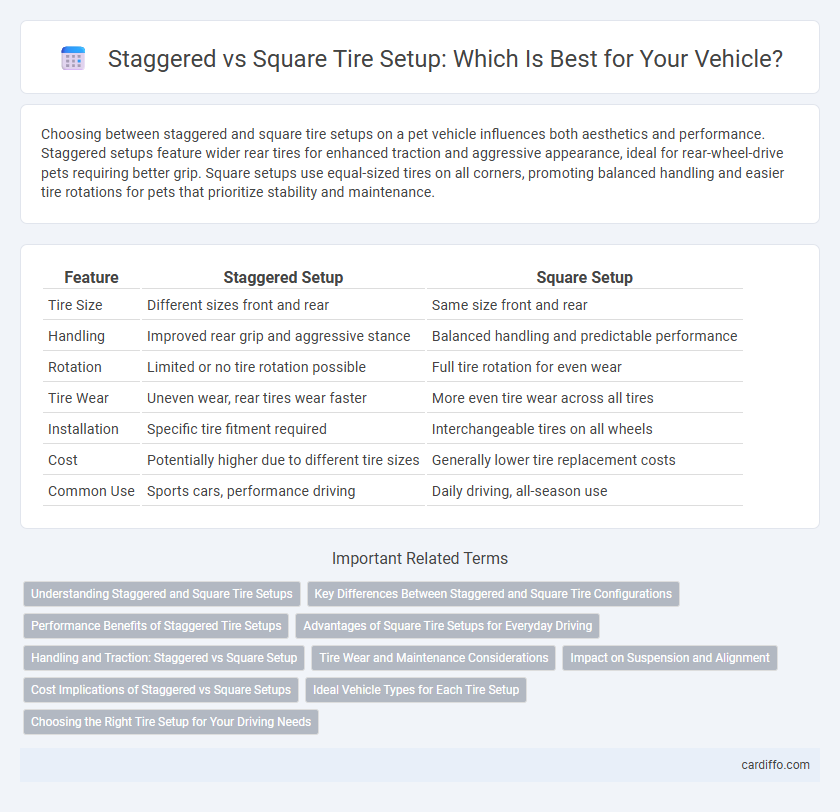Choosing between staggered and square tire setups on a pet vehicle influences both aesthetics and performance. Staggered setups feature wider rear tires for enhanced traction and aggressive appearance, ideal for rear-wheel-drive pets requiring better grip. Square setups use equal-sized tires on all corners, promoting balanced handling and easier tire rotations for pets that prioritize stability and maintenance.
Table of Comparison
| Feature | Staggered Setup | Square Setup |
|---|---|---|
| Tire Size | Different sizes front and rear | Same size front and rear |
| Handling | Improved rear grip and aggressive stance | Balanced handling and predictable performance |
| Rotation | Limited or no tire rotation possible | Full tire rotation for even wear |
| Tire Wear | Uneven wear, rear tires wear faster | More even tire wear across all tires |
| Installation | Specific tire fitment required | Interchangeable tires on all wheels |
| Cost | Potentially higher due to different tire sizes | Generally lower tire replacement costs |
| Common Use | Sports cars, performance driving | Daily driving, all-season use |
Understanding Staggered and Square Tire Setups
A staggered tire setup features wider tires on the rear axle than the front, enhancing traction and handling for high-performance rear-wheel-drive vehicles. In contrast, a square tire setup uses identical tire sizes on all four wheels, promoting even wear, easier rotation, and balanced handling characteristics suitable for year-round driving. Choosing between staggered and square setups depends on vehicle type, driving conditions, and performance goals, with staggered setups favoring aggressive cornering and square setups offering versatility and cost efficiency.
Key Differences Between Staggered and Square Tire Configurations
Staggered tire configurations feature wider tires on the rear axle and narrower tires on the front, enhancing traction and handling for rear-wheel drive vehicles and high-performance sports cars. Square setups use the same tire size on all four wheels, promoting even tire wear and simplified replacement, ideal for balanced handling and cost efficiency. The key difference lies in staggered setups optimizing rear-end grip and aesthetic appeal, while square setups prioritize uniform tire performance and maintenance.
Performance Benefits of Staggered Tire Setups
Staggered tire setups, featuring wider rear tires compared to the front, enhance traction and stability during high-performance driving by improving rear grip and reducing oversteer. This configuration optimizes power delivery in rear-wheel-drive vehicles, resulting in better acceleration and cornering capabilities on both track and road surfaces. The wider rear tires also aid in heat dissipation, contributing to consistent tire performance under demanding driving conditions.
Advantages of Square Tire Setups for Everyday Driving
Square tire setups, with identical tire sizes on all four wheels, provide consistent road contact and uniform wear, enhancing overall tire longevity and cost-effectiveness. This configuration improves vehicle stability and predictable handling during everyday driving conditions, ensuring a balanced grip across all wheels. Maintenance becomes simpler with interchangeable tires, reducing the need for specialized rotations or replacements.
Handling and Traction: Staggered vs Square Setup
A staggered tire setup places wider tires on the rear axle, enhancing rear traction and improving straight-line acceleration, which benefits handling in powerful rear-wheel-drive vehicles. In contrast, a square setup uses the same tire size on all four wheels, providing balanced handling and allowing for tire rotation to promote even tire wear and optimal traction under various driving conditions. While staggered setups excel in high-performance cornering and rear-end stability, square setups offer improved overall grip and predictable handling dynamics on different road surfaces.
Tire Wear and Maintenance Considerations
A staggered tire setup, featuring different sizes on the front and rear axles, often results in uneven tire wear due to variations in load distribution, necessitating regular monitoring and potential early replacement. Square setups utilize identical tires on all four corners, promoting even tire wear and simplifying tire rotation patterns, which can extend tire life and reduce maintenance complexity. Regular alignment checks are critical in both setups to minimize uneven wear and optimize performance.
Impact on Suspension and Alignment
A staggered tire setup, where the rear tires are wider than the fronts, can improve traction and handling but may place uneven stress on suspension components, potentially leading to accelerated wear and altered alignment settings. In contrast, a square setup, with all four tires matching in size, promotes balanced suspension loads and consistent alignment geometry, enhancing tire wear uniformity and suspension longevity. Proper alignment adjustments are crucial in staggered setups to counteract differences in tire size and maintain optimal handling characteristics.
Cost Implications of Staggered vs Square Setups
Staggered tire setups increase costs due to the need for different tire sizes on the front and rear axles, limiting tire rotation options and accelerating uneven wear replacement. Square setups use identical tire sizes on all wheels, enabling easier rotation and extended tire life, reducing overall maintenance expenses. Budget-conscious drivers often prefer square setups to minimize frequent tire purchases and maximize cost efficiency.
Ideal Vehicle Types for Each Tire Setup
Staggered tire setups, featuring wider rear tires than front, are ideal for high-performance sports cars and rear-wheel-drive vehicles seeking enhanced traction and aggressive handling. Square setups, with uniform tire sizes on all wheels, suit all-wheel-drive and daily driven vehicles, promoting even tire wear and balanced cornering stability. Performance enthusiasts prioritize staggered setups for maximum grip, while practicality favors square setups for tire rotation flexibility and longer tread life.
Choosing the Right Tire Setup for Your Driving Needs
A staggered tire setup features wider tires on the rear axle and narrower tires on the front, enhancing traction and stability during high-performance driving or rear-wheel-drive vehicles. A square setup uses tires of the same size on all four corners, promoting even wear, better rotation flexibility, and balanced handling, ideal for all-season driving and maximizing tire lifespan. Selecting the right tire setup depends on your vehicle type, driving style, and road conditions to optimize performance, safety, and tire longevity.
Staggered setup vs square setup Infographic

 cardiffo.com
cardiffo.com